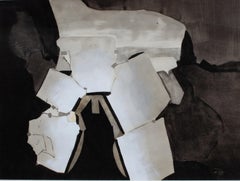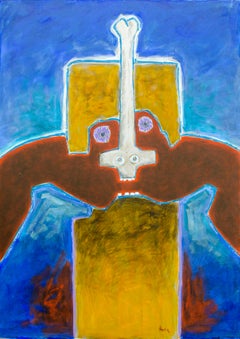David Hare Art
David Hare, a surrealist and Abstract Expressionist sculptor and photographer, was born in New York City on March 10, 1917. From 1936–37, he studied biology and chemistry at Bard College in Annandale-on-Hudson, New York. Hare had no formal training in art but began experimenting. He took up photography in the 1930s and by the end of the decade was working in color. The Walker Galleries in New York exhibited his photographs in 1939. From 1941–44, Hare founded and edited the surrealist magazine VVV with André Breton, Marcel Duchamp and Max Ernst. Peggy Guggenheim presented solo shows of Hare's work in her The Art of This Century Gallery from 1944–47. In 1948, he was a founding member, together with William Baziotes, Robert Motherwell and Mark Rothko, of The Subjects of the Artist school in New York and Hare, became friendly with Jean-Paul Sarte. Hare died on December 21, 1992, in Jackson.
1970s Abstract David Hare Art
Acrylic, Paper, Ink, Graphite
1950s Abstract David Hare Art
Bronze
1970s Abstract David Hare Art
Paper, Ink, Graphite
1970s Abstract David Hare Art
Linen, Paper, Acrylic
1970s Abstract David Hare Art
Acrylic
1970s Abstract David Hare Art
Linen, Acrylic
1960s Abstract David Hare Art
Paper, Acrylic, Graphite
1970s Abstract David Hare Art
Linen, Acrylic
1960s David Hare Art
Linen, Paper, Acrylic
1990s Abstract David Hare Art
Paper, Ink, Board
1990s Abstract David Hare Art
Paper, Acrylic, Board
1990s Abstract David Hare Art
Linen, Acrylic
1970s Abstract David Hare Art
Ink, Acrylic, Board
1970s David Hare Art
Linen, Acrylic
1970s Surrealist David Hare Art
Acrylic, Board
21st Century and Contemporary Abstract David Hare Art
Metal, Bronze
21st Century and Contemporary Abstract David Hare Art
Varnish, Oil Pastel, Archival Ink, Oil, Acrylic, Archival Paper, Graphite
21st Century and Contemporary Abstract David Hare Art
Linen, Charcoal, Pastel, Oil, Acrylic
21st Century and Contemporary Abstract David Hare Art
Bronze
2010s Abstract Expressionist David Hare Art
Linen, Mixed Media, Acrylic
21st Century and Contemporary Abstract David Hare Art
Oil Pastel, Archival Ink, Oil, Acrylic, Archival Paper, Graphite
Mid-20th Century Abstract David Hare Art
Bronze
21st Century and Contemporary Abstract David Hare Art
Bronze, Metal
2010s Abstract David Hare Art
Wax Crayon, India Ink, Encaustic, Archival Paper, Rice Paper, Pen, Color...
21st Century and Contemporary Abstract David Hare Art
Varnish, Oil Pastel, Archival Ink, Oil, Acrylic, Archival Paper, Graphite
1980s Abstract Geometric David Hare Art
Canvas, Acrylic
21st Century and Contemporary Abstract Impressionist David Hare Art
Canvas, Linen, Mixed Media, Oil, Acrylic







